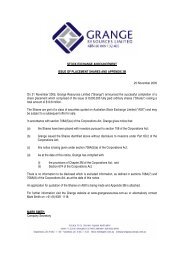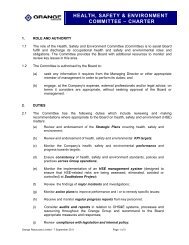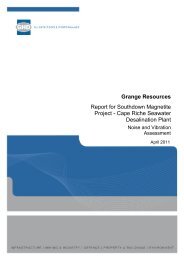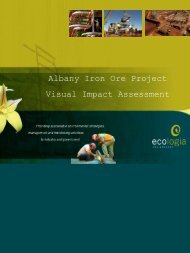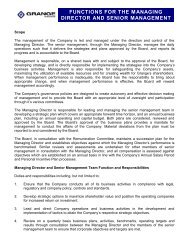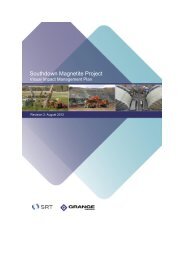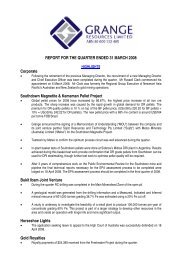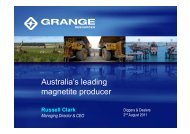2012 Annual Report (2 April 2013) - Grange Resources
2012 Annual Report (2 April 2013) - Grange Resources
2012 Annual Report (2 April 2013) - Grange Resources
You also want an ePaper? Increase the reach of your titles
YUMPU automatically turns print PDFs into web optimized ePapers that Google loves.
<strong>2012</strong> ANNUAL REPORT<br />
55<br />
PAGE<br />
Derivatives that do not qualify for hedge accounting<br />
Certain derivative instruments do not qualify for hedge<br />
accounting. Changes in the fair value of any derivative instruments<br />
that do not qualify for hedge accounting are recognised<br />
immediately in profit or loss.<br />
Embedded derivatives<br />
Derivatives embedded in other financial instruments or other host<br />
contracts are treated as separate derivatives when their risks and<br />
characteristics are not closely related to those of host contracts<br />
and the host contracts are not measured at fair value with<br />
changes in fair value recognised in profit or loss.<br />
(w) Financial instruments issued by the company<br />
Transaction costs on the issue of equity instruments<br />
Transaction costs arising on the issue of equity instruments are<br />
recognised directly in equity as a reduction of the proceeds of the<br />
equity instruments to which the costs relate. Transaction costs are<br />
the costs that are incurred directly in connection with the issue of<br />
those equity instruments and which would not have been incurred<br />
had those instruments not been issued.<br />
Interest and dividends<br />
Interest and dividends are classified as expenses or as<br />
distributions of profit consistent with the balance sheet<br />
classification of the related debt or equity instruments or<br />
component parts of compound instruments.<br />
(x) Non-current assets held for sale<br />
Non-current assets (and disposal groups) classified as held for<br />
sale are measured at the lower of carrying amount and fair value<br />
less costs to sell.<br />
Non-current assets and disposal groups are classified as held<br />
for sale if their carrying amount will be recovered through a sale<br />
transaction rather than through continuing use. This condition<br />
is regarded as met only when the sale is highly probable and<br />
the asset (or disposal group) is available for immediate sale in<br />
its present condition. The sale of the asset (or disposal group)<br />
is expected to be completed within one year from the date of<br />
classification.<br />
recognised by the date of the sale of the non-current asset is<br />
recognised at the date of derecognition.<br />
Non-current assets are not depreciated or amortised while<br />
they are classified as held for sale. Interest and other expenses<br />
attributable to the liabilities of a disposal group classified as held<br />
for sale continue to be recognised.<br />
Non-current assets classified as held for sale and the assets of a<br />
disposal group classified as held for sale are presented separately<br />
from the other assets in the balance sheet. The liabilities of a<br />
disposal group are held for sale are presented separately from<br />
other liabilities in the balance sheet.<br />
(y) Ore reserves<br />
The Company estimates its mineral resources and ore reserves<br />
based on information compiled by Competent Persons as<br />
defined in accordance with the Australasian Code for <strong>Report</strong>ing<br />
of Exploration Results, Mineral <strong>Resources</strong> and Ore Reserves<br />
of December 2004 (the JORC code). Reserves, and for certain<br />
mineral resources, determined in this way are used in the<br />
calculation of depreciation, amortisation and impairment charges,<br />
the assessment of life of mine stripping ratios and for forecasting<br />
the timing of the payment of close down and restoration costs.<br />
In assessing the life of a mine for accounting purposes, mineral<br />
resources are only taken into account where there is a high<br />
degree of confidence of economic extraction.<br />
(z) Trade and other payables<br />
Trade payables and other payables are carried at amortised cost<br />
and represent liabilities for goods and services provided to the<br />
Group prior to the end of the financial period that are unpaid and<br />
arise when the Group becomes obliged to make future payments<br />
in respect of the purchase of these goods and services. The<br />
amounts are unsecured and are usually paid within 30 days of<br />
recognition.<br />
An impairment loss is recognised for any initial or subsequent<br />
write-down of the asset to fair value less costs to sell. A gain is<br />
recognised for any subsequent increases in fair value less costs<br />
to sell of an asset, but not in excess of any cumulative impairment<br />
loss previously recognised. A gain or loss not previously



